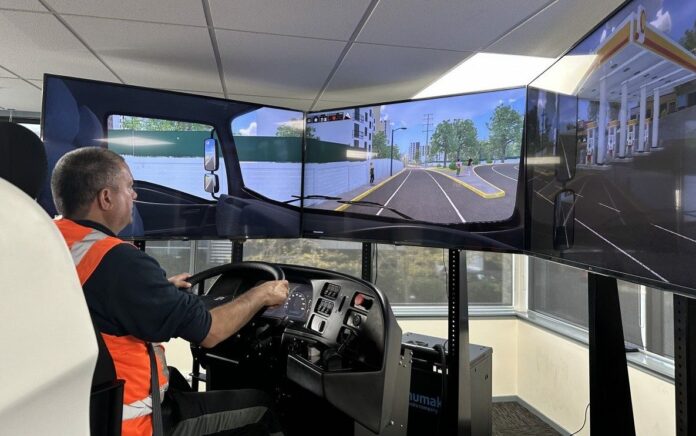The launch of +IMPAC VRC’s Whiti Supply Chain truck driver training programme — using a New Zealand-first state-of-the-art simulator technology — is expected to reduce New Zealand’s home-grown truck driver shortage by slashing the qualifying period from six months to two weeks.
The course accelerates learning, and introduces tools that build competence faster while significantly improving safety outcomes for novice drivers.
+IMPAC Virtual Reality Competency (VRC) general manager Andrew Stone says the Whiti Supply Chain Programme (in partnership with the logistics industry and the Ministry of Social Development) has already revolutionised the safety training qualifications of new forklift operators through virtual reality simulator technology.
“We recently launched the truck driver training course where the world’s leading truck driving simulator is a key component, but there is so much more to the programme than the virtual reality technology, including components like CV development and job skills,” Stone says.
+IMPAC truck training course lead Sam Stone — himself no stranger to teaching novice drivers after a decade of doing so in the New Zealand Defence Force — says the truck driving simulator empowers candidates, many of them beneficiaries, to climb behind the wheel of a truck with the competency and belief they need to do the job.
“It is a considerably safer way to train new drivers because they are not going straight from classroom to real truck,” Stone says.
“They go from classroom to simulator to truck, so we’re not just putting newbies behind the wheel of four tonnes of steel. They step into the real thing, already knowing the process — the dashboard isn’t a strange collection of buttons and levers.”
The introduction of truck simulator training is a game changer because it cuts the stand-down period between learners and full licence to just two weeks, significantly reducing costs and nurturing aspiring drivers through the unit standards and road code learning and assessment.
A far safer way to train aspiring drivers, the simulator also helps produce safer novice drivers. Not only do the truck simulators fast-track driver training for a lot less money, but they also make the career more attractive to young people.
Until now, it has not been a career that has attracted young people due to the obstacles.
“Our truck driving workforce is ageing. Most drivers are in their forties and fifties. With the simulator there are fewer obstacles, and the technology gamifies the learning process,” Stone says.
The traditional methods of training truck drivers in New Zealand involve a significant amount of time learning at home, usually alone.
Candidates are left to their own devices, with little in the way of tutoring and mentoring through the process.
“They no longer have to do this independently because they have instructors and assessors walking them through the training.
“They don’t have to sit online theory tests on their own, and they achieve their full Class 2 licence in two weeks,” Stone says.
In addition, candidates are taught skills such as preparing a CV. “It’s as much an employment course as a driver’s course.”
While students are on the truck simulators, trainers sit behind their consoles to monitor training in real time and, unlike traditional driver training, there is the ability to introduce all kinds of hazards, from cyclists to snow and other dangerous weather conditions such as sunstrike and, importantly, wind velocity.
The technology provides real-time assessments of where the driver has performed well or poorly, as well as mistakes and efficiencies with an objectivity that only solid data can provide.
The simulator also puts drivers through the experience of what it’s like to drive drunk or fatigued, and correct gearing and exhaust braking.
The session reports are helpful in training new drivers and assessing the skills of experienced drivers because, with data, there is no room for subjectivity.




